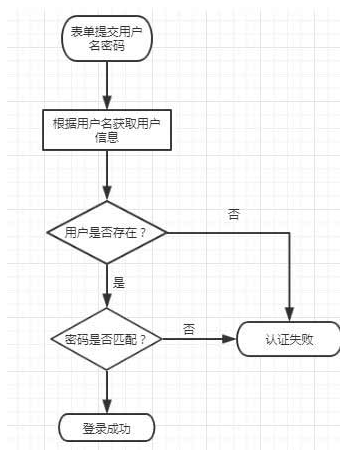说明 springboot 版本 2.0.3
源码地址:点击跳转
系列
一、 介绍
Spring Security 是一个能够为基于 Spring 的企业应用系统提供声明式的安全访问控制解决方案的安全框架。它提供了一组可以在 Spring 应用上下文中配置的 Bean,充分利用了 Spring IoC,DI(控制反转 Inversion of Control ,DI:Dependency Injection 依赖注入)和 AOP(面向切面编程)功能,为应用系统提供声明式的安全访问控制功能,减少了为企业系统安全控制编写大量重复代码的工作。
二、 环境搭建
建立 springboot2 项目,加入 security 依赖,mybatis 依赖
<dependency>
<groupId>org.springframework.boot</groupId>
<artifactId>spring-boot-starter-security</artifactId>
</dependency>
<dependency>
<groupId>org.mybatis.spring.boot</groupId>
<artifactId>mybatis-spring-boot-starter</artifactId>
<version>1.3.2</version>
</dependency>
<dependency>
<groupId>mysql</groupId>
<artifactId>mysql-connector-java</artifactId>
<scope>runtime</scope>
</dependency>
数据库为传统的用户–角色–权限,权限表记录了 url 和 method,springboot 配置文件如下:
mybatis:
type-aliases-package: com.example.demo.entity
server:
port: 8081
spring:
datasource:
driver-class-name: com.mysql.jdbc.Driver
url: jdbc:mysql://localhost:3306/test?useUnicode=true&characterEncoding=utf-8&useSSL=true
username: root
password: 123456
http:
encoding:
charset: utf-8
enabled: true
springboot 启动类中加入如下代码,设置路由匹配规则。
@Override
protected void configurePathMatch(PathMatchConfigurer configurer) {
configurer.setUseSuffixPatternMatch(false) //设置路由是否后缀匹配,譬如/user能够匹配/user.,/user.aa
.setUseTrailingSlashMatch(false); //设置是否后缀路径匹配,比如/user能够匹配/user,/user/
}
三、 security 配置
默认情况下 security 是无需任何自定义配置就可使用的,我们不考虑这种方式,直接讲如何个性化登录过程。
1、 建立 security 配置文件,目前配置文件中还没有任何配置。
@Configuration
public class SecurityConfig extends WebSecurityConfigurerAdapter {
}
2、 个性化登录,security 中的登录如下:

- security 需要一个 user 的实体类实现
UserDetails接口,该实体类最后与系统中用户的实体类分开,代码如下:
public class SecurityUser implements UserDetails{
private static final long serialVersionUID = 1L;
private String password;
private String name;
List<GrantedAuthority> authorities;
public SecurityUser(string name,string password) {
this.id = id;
this.password = password;
this.name = name;
this.age = age;
}
public void setAuthorities(List<GrantedAuthority> authorities) {
this.authorities = authorities;
}
@Override
public Collection<GrantedAuthority> getAuthorities() {
return this.authorities;
}
@Override //获取校验用户名
public String getUsername() {
return String.valueOf(this.id);
}
@Override //获取校验用密码
public String getPassword() {
return password;
}
@Override //账户是否未过期
public boolean isAccountNonExpired() {
// TODO Auto-generated method stub
return true;
}
@Override //账户是否未锁定
public boolean isAccountNonLocked() {
// TODO Auto-generated method stub
return true;
}
@Override //帐户密码是否未过期,一般有的密码要求性高的系统会使用到,比较每隔一段时间就要求用户重置密码
public boolean isCredentialsNonExpired() {
// TODO Auto-generated method stub
return true;
}
@Override //账户是否可用
public boolean isEnabled() {
// TODO Auto-generated method stub
return true;
}
}
- 编写了实体类还需要编写一个服务类 SecurityService 实现
UserDetailsService接口,重写 loadByUsername 方法,通过这个方法根据用户名获取用户信息,代码如下:
@Component
public class SecurityUserService implements UserDetailsService {
@Autowired
private JurisdictionMapper jurisdictionMapper;
@Autowired
private UserMapper userMapper;
private Logger log = LoggerFactory.getLogger(this.getClass());
@Override
public UserDetails loadUserByUsername(String username) throws UsernameNotFoundException {
log.info("登录用户id为:{}",username);
int id = Integer.valueOf(username);
User user = userMapper.getById(id);
if(user==null) {
//抛出错误,用户不存在
throw new UsernameNotFoundException("用户名 "+username+"不存在");
}
//获取用户权限
List<GrantedAuthority> authorities = new ArrayList<>();
List<Jurisdiction> jurisdictions = jurisdictionMapper.selectByUserId(id);
for(Jurisdiction item : jurisdictions) {
GrantedAuthority authority = new MyGrantedAuthority(item.getMethod(),item.getUrl());
authorities.add(authority);
}
SecurityUser securityUser = new SecurityUser(user.getName(),user.getPassword(),authority):
user.setAuthorities(authorities);
return securityUser;
}
}
- 通常我们会对密码进行加密,所有还要编写一个 passwordencode 类,实现 PasswordEncoder 接口,代码如下:
@Component
public class MyPasswordEncoder implements PasswordEncoder {
private Logger log = LoggerFactory.getLogger(this.getClass());
@Override //不清楚除了在下面方法用到还有什么用处
public String encode(CharSequence rawPassword) {
return StringUtil.StringToMD5(rawPassword.toString());
}
//判断密码是否匹配
@Override
public boolean matches(CharSequence rawPassword, String encodedPassword) {
return encodedPassword.equals(this.encode(rawPassword));
}
}
3、 编辑配置文件
- 编写 config Bean 以使用上面定义的验证逻辑,securityUserService、myPasswordEncoder 通过@Autowired 引入。
@Override
protected void configure(AuthenticationManagerBuilder auth) throws Exception {
auth.userDetailsService(securityUserService)
.passwordEncoder(myPasswordEncoder);
}
- 然后编写 configure Bean(和上一个不一样,参数不同),实现 security 验证逻辑,代码如下:
@Override
protected void configure(HttpSecurity http) throws Exception {
http
.csrf() //跨站
.disable() //关闭跨站检测
.authorizeRequests()//验证策略策略链
.antMatchers("/public/**").permitAll()//无需验证路径
.antMatchers("/login").permitAll()//放行登录
.antMatchers(HttpMethod.GET, "/user").hasAuthority("getAllUser")//拥有权限才可访问
.antMatchers(HttpMethod.GET, "/user").hasAnyAuthority("1","2")//拥有任一权限即可访问
//角色类似,hasRole(),hasAnyRole()
.anyRequest().authenticated()
.and()
.formLogin()
.loginPage("/public/unlogin") //未登录跳转页面,设置了authenticationentrypoint后无需设置未登录跳转页面
.loginProcessingUrl("/public/login")//处理登录post请求接口,无需自己实现
.successForwardUrl("/success")//登录成功转发接口
.failureForwardUrl("/failed")//登录失败转发接口
.usernameParameter("id") //修改用户名的表单name,默认为username
.passwordParameter("password")//修改密码的表单name,默认为password
.and()
.logout()//自定义登出
.logoutUrl("/public/logout") //自定义登出api,无需自己实现
.logoutSuccessUrl("public/logoutSuccess")
}
到这里便可实现 security 与 springboot 的基本整合。
四、实现记住我功能
1、 建表
记住我功能需要数据库配合实现,首先要在数据库建一张表用户保存 cookie 和用户名,数据库建表语句如下:不能做修改
CREATE TABLE `persistent_logins` (
`username` varchar(64) NOT NULL,
`series` varchar(64) NOT NULL,
`token` varchar(64) NOT NULL,
`last_used` timestamp NOT NULL DEFAULT CURRENT_TIMESTAMP ON UPDATE CURRENT_TIMESTAMP,
PRIMARY KEY (`series`)
)
2、 编写 rememberMeservice Bean
代码如下:
@Bean
public RememberMeServices rememberMeServices(){
JdbcTokenRepositoryImpl jdbcTokenRepository = new JdbcTokenRepositoryImpl();
jdbcTokenRepository.setDataSource(dataSource);
PersistentTokenBasedRememberMeServices rememberMeServices =
new PersistentTokenBasedRememberMeServices("INTERNAL_SECRET_KEY",securityUserService,jdbcTokenRepository);
//还可设置许多其他属性
rememberMeServices.setCookieName("kkkkk"); //客户端cookie名
return rememberMeServices;
}
dataSource 为@Autowired 引入
3、 配置文件设置 remember
在 config(HttpSecurity http)中加入记住我功能
.rememberMe()
.rememberMeServices(rememberMeServices())
.key("INTERNAL_SECRET_KEY")
在登录表单中设置 remember-me 即可实现记住我功能。

